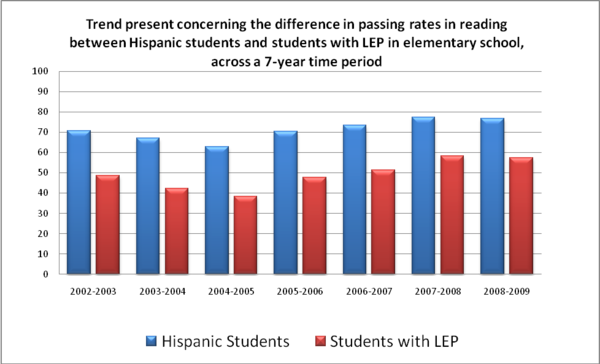| << Chapter < Page | Chapter >> Page > |

For the 7-year time period, the trend concerning the difference in passing rates in math between Hispanic students and students who were LEP in elementary school revealed a continuous achievement gap. Specifically, a trend with differences between Hispanic students and students who were LEP was present across the 7-years of data analyzed. Average differences between Hispanic students were 10.96% to 24.56% higher than students who were LEP for math, over the 7-year time period. Differences in passing rates in math between Hispanic students and students who were LEP were evident throughout the 7-year testing period (http://ritter.tea.state.tx.us/student.assessment/resources/studies/testingtimeline.pdf).
Differences in passing rates between Hispanic students and students who were LEP were discernible during the 2004-2005 school year, which coincided with the accountability measures of the No Child Left Behind Act (http://ritter.tea.state.tx.us/student.assessment/resources/studies/testingtimeline.pdf). As previously mentioned, this law was enacted to bring stricter accountability for school campuses and districts, as well as 100% passing rates for all students by the 2013-2014 school year. The greatest difference in achievement between Hispanic students and students who were LEP was most evident during the 2004-2005 school years. This wide discrepancy in passing rate between students corresponds with the first two years of administration of the Texas Assessment of Knowledge and Skills test (http://ritter.tea.state.tx.us/student.assessment/resources/studies/testingtimeline.pdf). By the 2006-2007 school year, the mean difference between both groups began to decline and continued to decline the following school years. The narrowest gap was evident during the 2008-2009 school year (10.96%). All 7 years had moderate to large effect sizes (Cohen, 1988). Readers are referred to Figure 2 for the trend that was present concerning the difference in passing rates in reading between Hispanic students and students who were LEP, across a 7-year time period.

In this study, we examined the passing rates in reading and the passing rates in math of Hispanic students and of students designated as Limited English Proficient on a state-mandated assessment measure for the last 7 years of available data. Statistically significant differences were yielded in reading for all years of data. Across the 7-year time period, the average passing rate in reading for Hispanic students was 71.33% whereas, for students who were LEP, the average passing rate was 49.19%. For the 2003-2009 data analyzed, Hispanic students outperformed students who were LEP by an average of 22.14% in reading. The effect size range for the 7-year time period was large (1.21- 1.51).
Examining the presence of trends in reading between Hispanic students and students who were Limited English Proficient, across a 7-year time period were examined, an achievement gap was clearly present. For each year analyzed, Hispanic students surpassed students with LEP in reading. Passing rates for in reading for Hispanic students averaged 19.19% to 24.94% higher than for students who were LEP. Distinctions in the effect size may coincide with the implementation of the NCLB Act which increased federal funding for school districts and public schools, but also increased accountability and high academic standards, as well as requiring all students with LEP to become proficient in English (Yell&Drasgow, 2005). The wide discrepancy in passing rate between students also appears to correspond with the change in administration from the Texas Assessment of Academic Skills measure to the Texas Assessment of Knowledge and Skills test (http://ritter.tea.state.tx.us/student.assessment/resources/studies/testingtimeline.pdf).

Notification Switch
Would you like to follow the 'The achievement gap between white and non-white students' conversation and receive update notifications?